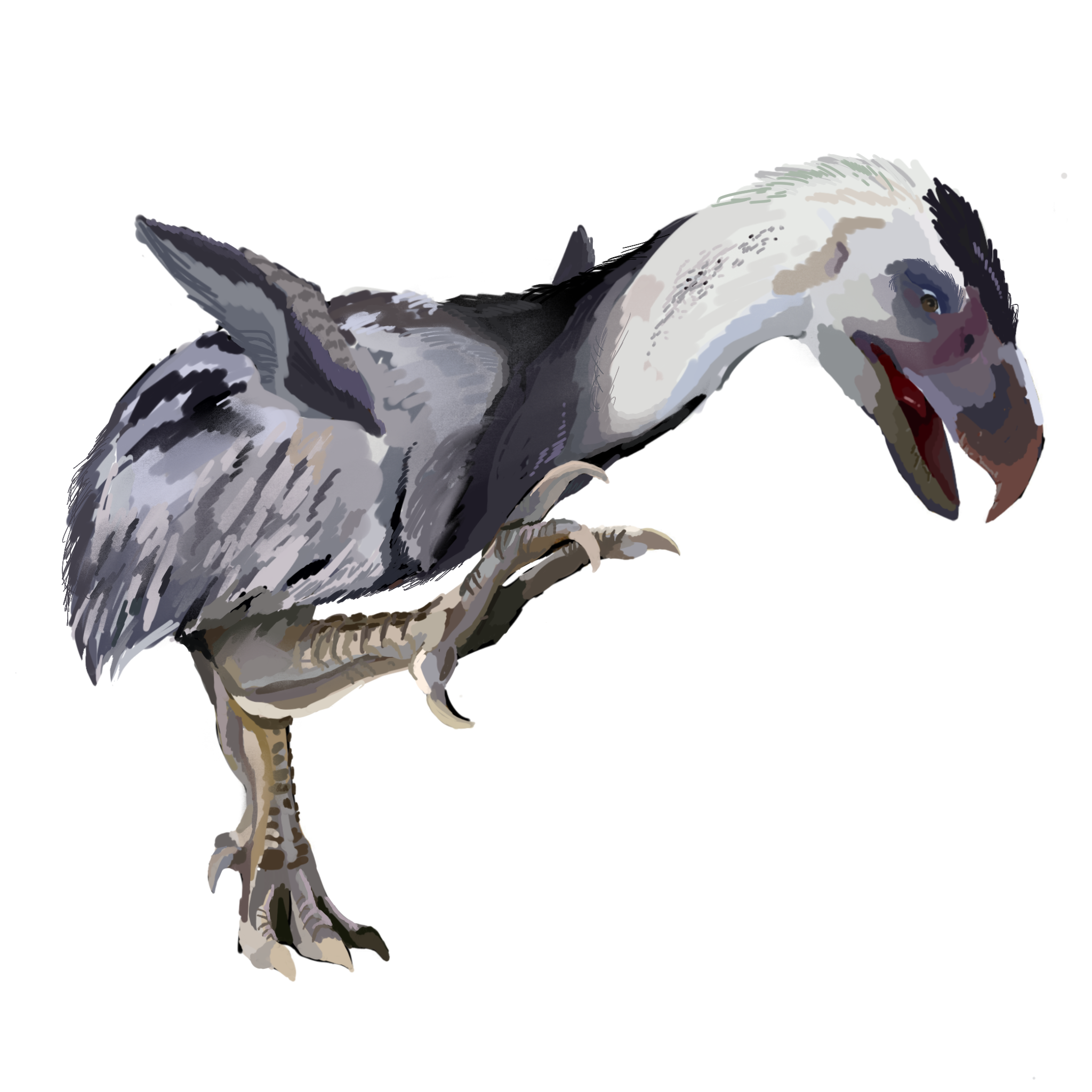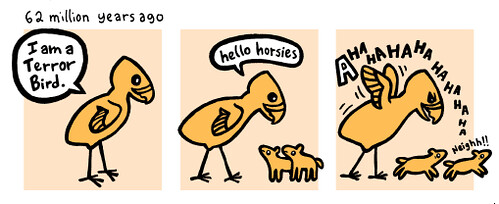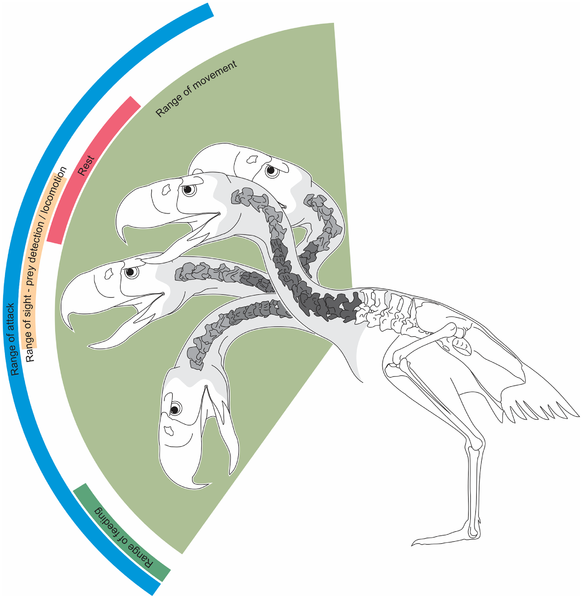
Image Credit: Alexoatss, https://commons.wikimedia.org/wiki/File:Reconstruction_drawing_of_Titanis_walleri.png
🎶”Titanis, The Teerror Biird“🎶
Listening to the song “Titanis the Terror Bird” by Howdytoons makes me imagine Titanis as an action movie hero, adventuring into strange new lands and encountering new fierce mammalian adversaries. But what do we know about “Titanis the Terror Bird?”
Before we get into the details, it is necessary to set some groundwork with a bit of Titanis family history. Titanis walleri (meaning “Waller’s Titan”, after Benjamin Walker, who discovered the first Titanis fossils) was a member of the now extinct group of birds known as the Phorusrhacidae. However, many people know this group by the nickname, “The Terror Birds!” They first evolved in South America roughly 60 million years ago during the Palaeocene period. This was not long, geologically speaking, after their close kin, the non-avian dinosaurs, had been laid to rest in the fires of a meteor strike. During this time South America was an isolated continent and was not connected to North America as it is today. As a result, there were few competitors for the throne of “top predator”, and the Phorusrhacids quickly established themselves, occupying this niche for the next 55 million years. The only other carnivorous competitors in South America at this time were snakes, crocodilians and a now extinct group of mammals known as the “Sparassodonts” (whose most famous member is Thylacosmilus, a carnivore which convergently evolved sabre teeth similar to the “Sabre-Tooth Cats”). However, apart from one or two snake (e.g., Titanoboa) and Crocodilian species (e.g., Purrusaurus), none reached the same or surpassed the towering sizes of the Phorusrhacids, and none occupied the top predator niche for as long. But then, 3 million years ago, the status quo changed. The movement of continents brought South and North America closer together and a land bridge formed. This allowed animal life to mix and migrate, with North American animals such as Sabre-Tooth Cats (e.g., Smilodon), the Elephant-like “Gomphotheres”, Horses, Camels and more spreading into South America. Conversely South American animals were able to migrate the other way. This included megafauna such as the Ground Sloths (e.g., Megatherium), giant relatives of armadillos known as the “Glyptodonts” and smaller animals such as the opossum. This event is known as the “Great American Interchange”, and the Phorusrhacids were among the animals that took advantage of this new opportunity.

Image Credit: Chris Lott, https://www.flickr.com/photos/fncll/2126620964
We know that the Phorusrhacids spread north due to the discovery of Titanis. To date it remains the only Phorusrhacid known from North America, spreading into the continent as it followed its migrating prey. What is fascinating about Titanis’ North American presence is that dating of the sediments its fossils were found in indicates that the earliest Titanis were present in the continent 5 million years ago. At this point the land bridge between South and North America had not yet fully formed and would not do so for another 2 million years. So how in the world did Titanis make it there? Well, since it couldn’t fly it is theorised that it migrated by island hopping across the proto-land bridge. When it finally reached North America Titanis thrived in its new home, with the very latest fossils found in sediments dating from only 1.8 million years ago. After this time Titanis disappears from the fossil record, going extinct probably due to climate change, which affected their prey resources. None the less, Titanis was present on American soil for roughly 3.2 million years, much to the dismay of generations of North American mammalian herbivores!
Unfortunately, when it comes to Titanis walleri fossils, there isn’t much to go on! This is because the fossils are rather scrappy, consisting of just a few toe bones and a couple of leg bones discovered from sites in Texas and Florida. From these fragments it has been estimated that Titanis would’ve stood between 1.4 to 1.9 metres tall and weighed around 150 kilograms. This is around the size of the biggest Ostrich, the largest modern bird. However, there were other Phorusrachids that grew even larger than this! For example, the largest Phorusrhacid found, a 12 million year old South American species named Kelenken guillermi, stood between 2.28 to 3 metres tall and possessed a skull up to 71 centimetres long! So, it’s no exaggeration to say that Titanis and its brethren could grow pretty big! Because of the fragmentary nature of Titanis fossils we can’t be certain as to its true lifestyle. Therefore, to construct a picture of what Titanis was like we must use what we know about its Phorusrhacid cousins and modern-day relatives.
The first thing we can deduce about Titanis is that, like all Phorusrhacids, it was a carnivore. It hunted small and occasionally big game while also scavenging when it could. After all, why waste energy when you can pick up an easy meal! Exactly how Phorusrhacids like Titanis would have hunted was looked at by a study by Degrange et. al. in 2010. This study looked at the mechanical stress limits on the skull of Andalgalornis steulleti, a closely related Phorusrhacid that lived in South America roughly 20 million years ago. The study used computer models to assess the effect of different mechanical stresses on Andalgalornis’ skull. What they found was that it wasn’t great at withstanding lateral side to side forces but could take vertical forces from up and down movements well. The palaeontologists inferred from this that Andalgalornis’ skull (and therefore the skull of similar Phorusrhacids like Titanis) was not adapted for grabbing and holding onto large struggling prey. Instead, Phorusrhacids would have concentrated on small mammals, birds and reptiles where the stresses were less. Furthermore, Phorusrhacid skulls (like in Llallawavis scagliali a species described by Degrange et. al. in 2015) have joints between the skull bones that are more fused than in other birds, making the skull more rigid and robust so it could cope better with sharp up and down concussive movements. However, this doesn’t totally rule out the possibility that Phorusrhacids hunted large prey. To accomplish this, they would’ve used a different strategy. Using their skulls’ high resistance to vertical stresses, and their strong neck muscles they would strike with their beaks at the vulnerable neck and soft parts, inflicting deep puncture wounds and fractures. If repeated strikes didn’t overwhelm the prey, then shock and blood loss would, and as they fell the Phorusrhacid would move in to finish the job. To summarize, they would have pecked things to death! As if that wasn’t scary enough, it is also likely that Phorusrhacids could’ve used their powerful legs to deliver nasty kicks and stomps to their prey and any other predator that was bold enough to try and steal its kill. To add to their already deadly arsenal, some Phorusrhacids were also fast runners, using their speed to catch up with their prey. Titanis is thought to have been a speedster too, however not all Phorusrhacids were. Some, like Brontornis, were more robust and would’ve been ambush predators. You want more nightmare fuel? Their closest living relatives, ground living South American birds known as “Seriemas”, are known to hunt smaller prey by picking up and bashing it over and over on the ground. This strategy is brutally effective at breaking the preys’ bones and tenderising the meat, allowing for easier consumption. It is possible that Phorusrhacids also employed this same tactic, just on a larger scale! Wow, it’s no wonder they’re called Terror Birds!

Image Credit: Tambussi et. al. 2012, https://journals.plos.org/plosone/article?id=10.1371/journal.pone.0037701
When hearing about how predators like Titanis hunt, it’s easy for people to think of these animals as monsters. However, it must be stressed that they are NOT monsters, they are animals. Like a lot of living animals Titanis would’ve exhibited other, more peaceful behaviours. Evidence of parental care, courtship displays, and other aspects of behaviour has really been found yet in Phorusrhacids, but we can make informed speculations based on what we know about modern birds. Like all birds Titanis would’ve laid eggs, likely in a nest constructed in seclusion on the ground. The Phorusrhacid chicks would’ve required a level of parental care after birth. The extend of this is unknown but if it is like modern birds, then the young would’ve been raised for a period of months to years by one or both parents. The babies would’ve grown fast under this care, eventually reaching sizes where they would be large enough to fend for themselves. Once reaching adulthood Titanis would’ve been ready to breed. Once again, we can only speculate what courtship between Titanis individuals would’ve been like, but it is common for birds to make a display of some sort to attract a mate. This might involve displaying their arrangement of feathers, using bright colours, making vocalisations in the form of songs or a combination of the three. That 2015 study on Llallawavis scagliali skulls I mentioned earlier also looked at the structure of the inner ear canals and found that they were suited for hearing low frequency sounds, lower than the average frequency range of modern birds. If Titanis’ inner ears were similar, then its displays (and general communication) maybe involved a series of low calls and rumbles to potential mates, or as warnings to rivals. Imagine a Titanis birdsong, with low calls echoing across the plains as males put on their own unique concerts! Furthermore, if we look at large flightless birds like ostriches, emus and cassowaries then maybe Titanis could’ve used its feathers and small wings in display? Plenty of birds also employ bright colours too (e.g., Cassowaries are bright blue and red around their heads), so maybe Titanis could’ve had some bright colours too, potentially around the head and neck area? It’s fun to think about if you ask me!
Sure, Titanis could be terrifying, but you know what, I think this highly successful predator should be regarded as more than just a hunter. I believe it had a softer side that sadly, until more fossils of it and other Terror Birds are discovered, we can only imagine for now.

Image Credit: Amanda, https://www.flickr.com/photos/spakattacks/481991843/
References/Further Reading
• Baskin 1995 paper describing the occurrence of Titanis walleri from South Texas.
Jon A. Baskin (1995) The giant flightless bird Titanis walleri (Aves: Phorusrhacidae) from the Pleistocene coastal plain of south Texas, Journal of Vertebrate Paleontology, 15:4, 842-844, DOI: 10.1080/02724634.1995.10011266
• MacFadden et. al. 2007 paper that rexamined the timespan of Titanis walleri.
Bruce J. MacFadden, Joann Labs-Hochstein, Richard C. Hulbert, Jon A. Baskin; Revised age of the late Neogene terror bird (Titanis) in North America during the Great American Interchange. Geology 2007;; 35 (2): 123–126. doi: https://doi.org/10.1130/G23186A.1
Degrange FJ, Tambussi CP, Moreno K, Witmer LM, Wroe S (2010) Mechanical Analysis of Feeding Behavior in the Extinct “Terror Bird” Andalgalornis steulleti (Gruiformes: Phorusrhacidae). PLoS ONE 5(8): e11856. https://doi.org/10.1371/journal.pone.0011856
Blanco R. Ernesto and Jones Washington W 2005Terror birds on the run: a mechanical model to estimate its maximum running speedProc. R. Soc. B.2721769–1773, http://doi.org/10.1098/rspb.2005.3133
Black, Riley 2012, “Repost: Terror Birds Ain’t What They Used to Be – A Titanis Takedown”, National Geographic, www.nationalgeographic.com, 29TH May, 2012, https://www.nationalgeographic.com/science/article/repost-terror-birds-aint-what-they-used-to-be-a-titanis-takedown?cmpid=int_org=ngp::int_mc=website::int_src=ngp::int_cmp=amp::int_add=amp_readtherest
• A reconstruction made by Richard C Hulbert of Titanis walleri.
Revised age of the late Neogene terror bird (Titanis) in North America during the Great American Interchange – Scientific Figure on ResearchGate. Available from: https://www.researchgate.net/figure/Reconstruction-of-Titanis-walleri-based-on-40-fragmentary-bones-known-from-Neogene-of_fig1_249521166 [accessed 21 Aug, 2021]
Federico J. Degrange, Claudia P. Tambussi, Matías L. Taglioretti, Alejandro Dondas & Fernando Scaglia (2015) A new Mesembriornithinae (Aves, Phorusrhacidae) provides new insights into the phylogeny and sensory capabilities of terror birds, Journal of Vertebrate Paleontology, 35:2, DOI: 10.1080/02724634.2014.912656
• Tambussi et. al. 2012 paper analysing the neck flexibility of the Phorusrhacid Andalgalornis.
Tambussi CP, de Mendoza R, Degrange FJ, Picasso MB (2012) Flexibility along the Neck of the Neogene Terror Bird Andalgalornis steulleti (Aves Phorusrhacidae). PLOS ONE 7(5): e37701. https://doi.org/10.1371/journal.pone.0037701
• A BBC Earth article published on the 24th July 2015 and written by Niki Wilson on Terror Birds.
Wilson, Niki, “The reign of the terror birds”, BBC Earth, www.bbc.co.uk/earth, 24th July, 2015, http://www.bbc.co.uk/earth/story/20150727-the-reign-of-the-terror-birds